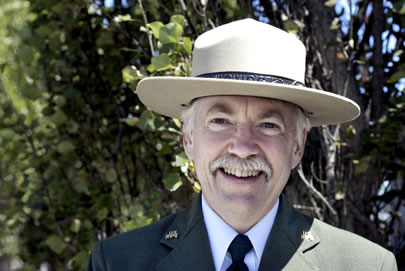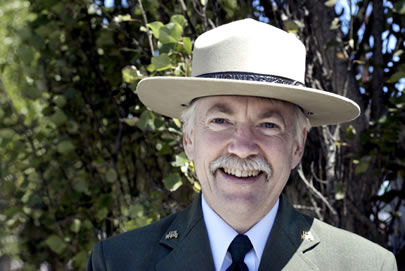 New Park Service Director Jonathan Jarvis: Friendly.Photo: National Park ServiceOne weekend this summer, my wife and I ferried across Puget Sound to Olympic National Park, chose a hiking route with the help of an awesomely smart and patient ranger, and set forth from the highest trailhead in the park. We crossed alpine ridges, dropped into a lush valley, frolicsome marmots etc., etc.
New Park Service Director Jonathan Jarvis: Friendly.Photo: National Park ServiceOne weekend this summer, my wife and I ferried across Puget Sound to Olympic National Park, chose a hiking route with the help of an awesomely smart and patient ranger, and set forth from the highest trailhead in the park. We crossed alpine ridges, dropped into a lush valley, frolicsome marmots etc., etc.
It wasn’t until we set up camp hours later that we discovered … I had forgotten our tent. Whoops. We slept under a ramshackle lean-to, and, fortunately, it didn’t rain.
Jonathan Jarvis, the newly confirmed director of the National Park Service, can’t do much to prevent boneheaded moves like mine. Truth be told, when we spoke this week I was too embarrassed to tell him about forgetting a tent. Instead, I asked about his 33 years in the park service, starting with a volunteer stint when he was fresh out of college and culminating later this month with an office view of the National Mall when the 56-year-old moves to Washington to assume his new post. Jarvis has been a park ranger and superintendent in parks across the West—in Alaska, Idaho, Washington state, and California. He raised his family in parks and worked most recently as director of the service’s Pacific West Region, based in Oakland.
In taking charge of one of America’s most beloved public institutions, Jarvis confronts a formidable list of challenges. Chief among them, he says, will be readying the parks for the ongoing effects of climate change.
Detailed in a recent report, those threats include more and fiercer wildfires, receding glaciers, a shift from spring rains to fall rains, and more rainfall on snow. The rainfall changes will increase flooding, says Jarvis.
“All of those are disturbing, of course, and they’re changing the parks in significant ways,” he said. “But they’re also teachable moments that allow us to communicate with the American public about how this climate-change thing is not some theoretical thing that’s only affecting the polar bears, but it’s actually affecting us here close to home.”
When he was superintendent of Mount Rainier National Park, visitors would ask what happened to the ice caves they remembered climbing in as kids.
“Rather than just saying ‘they’re gone’–because they are–there’s an opportunity to tell them that over the last 25 years, the Tahoma Glacier has receded hundreds of yards and the ice caves have disappeared,” he said. “Based on our long-terming monitoring, all the glaciers are receding. There’s strong scientific evidence that this is the result of climate change.”
I asked if climate change would be the foremost message that rangers would teach. That would be silly, Jarvis pointed out.
“There are ways to incorporate climate change into a lot of messages,” he said. “But, you know, it might be hard to have it part of your Civil War battlefield story. You could probably build it in, but it certainly shouldn’t be your predominate story.”
Fair enough. There’s also the issue of shifting habitats—animals and plant species moving in and out of parks in search of cooler or wetter climes, for example. Historically, Jarvis said, the park service has not done well managing at an ecosystem level by working with nearby landowners—private citizens, the U.S. Forest Service, the Bureau of Land Management, the Fish and Wildlife Service. One exception has been at Yellowstone National Park, where migratory bison have forced the park service to accommodate them. It can learn from this model, he said.
Another top goal, he said, is “to connect all Americans [emphasis his] to their national parks.”
“[Wallace] Stegner’s idea is that parks are democracy at its best,” he said.
I asked him about a fascinating profile of Shelton Johnson, one of a very few black park rangers, who notes that few African Americans visit parks. Jarvis spoke about the EcoHelpers program at Santa Monica Mountains National Recreation Area, which brought nearby urban youth into the park to help with restoration projects. The students then brought their parents to show off their work, in a model Jarvis would like to replicate elsewhere.
By the way, the parks system includes 58 national parks and 333 other units–national monuments, historical parks, battlefields, national lakeshores, seashores and parkways, wilderness areas and other cultural sites.
Does Jarvis’s job still sound fun? Here are a few more challenges:
- A staggering maintenance backlog swelled from a lack of funding during the Bush years. The stimulus bill provided nearly $1 billion for the parks, but Jarvis estimated the total backlog to be about $8 billion.
- Employee morale. Jarvis was blunt in answering what he thought was the biggest problem he inherited from the Bush administration. The notion that government can do nothing right, he said, weighs down on park service staff. “Employee morale in the system is pretty low, for a variety of reasons,” he said. Still, “I won’t lay it all on the feet of the previous administration.”
- Beginning in February, visitors will be able to carry loaded guns in parks. At his Senate confirmation hearing in July, Jarvis said the park service planned to train rangers and put up signs to explain the policy. “The last thing we want is to create confusion amongst the public and the users who are bringing their weapons to the park,” he said.
- The park service, like the broader conservation movement, must compete for attention among other pressing national issues. Jarvis sees a connection—coming to love natural places makes people more engaged citizens, he says.
“You hear stories about kids seeing the Milky Way for the first time, and they didn’t realize that the sky was full of stars, until they got out into these environments,” he said. “It changes them in profound ways. If we can give every American that opportunity … to see the Milky Way, to see wolves in the Lamar Valley of Yellowstone, to see natural fire burning, or to see the salmon running freely up a river–all of those things, I think, create a sense of social responsibility that will carry through the rest of their lives and make them better citizens.”
It’s a romantic notion. I guess the parks have that effect. Let’s end on a proper note:




